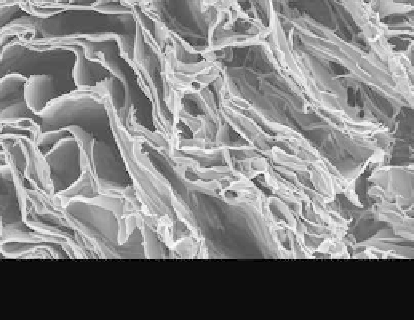Biomedical Engineering Reference
In-Depth Information
Freeze-drying of the liquid-liquid phase-separated polymer solution removes the solvent, produc-
ing a foam structure with pores that have the geometry of the solvent crystals. Temperature gra-
dients present along the direction of solidifi cation may account for the pore anisotropy observed
in foams fabricated using the TIPS process [83]. Various foam morphologies can be obtained by
systematically changing parameters involved in the TIPS process, including polymer type and con-
centration, coarsening conditions, solvent or nonsolvent composition, and inclusion of an additive
or particulates [84].
Tubular foam scaffolds fabricated using the TIPS process were prepared from poly(lactic-
co
-
glycolic acid) dissolved in dimethylcarbonate under magnetic stirring to produce a 5% (w/v) polymer
solution. The polymer solution was fi ltered through a 0.45 µm fi lter, cast onto a Petri dish and
transferred into a lyophilization fl ask, which was subsequently frozen for 2 h in liquid nitrogen. The
solvent in the cast polymer was then sublimated at
10°C for 48 h, and then at 0°C for an additional
48 h. Residual solvent was removed at room temperature.
The polymer membranes were rolled into
a tube and the opposing edges were joined by dissolving in chloroform and pressing them together.
The resulting tube had a lumen approximately 3 mm in diameter and walls approximately 1.5-2 mm
thick (Figure 20.8a). The porosity of the foam scaffolds was high (
−
93%) and the pore volume was
calculated to be 11.5 cm
3
/g. Two distinct pore sizes were present in the foam: macropores of
>
∼
100 µm
average diameter and interconnected micropores of 10-50 µm diameter (Figure 20.8b) [78].
However, unlike the fi brous scaffolds previously described, scaffolds fabricated by the TIPS
process failed to withstand compressive forces when implanted
in vivo
( Figu re 20.9). Such loss of t he
lumenal structure would impede the use of these scaffolds for intestinal tissue engineering in which
the ability to retain a tubular structure is crucial for the passage of nutrients through the gastroin-
testinal tract. Further modifi cation of the processing parameters combined with improved polymer
selection would probably increase the mechanical stability and prevent the scaffold collapsing.
The problem of good mechanical stability is not limited to tubular scaffolds produced by using the
TIPS process. Without further modifi cation, the ability of many of the different scaffolds developed to
date, to resist compressive forces, is unlikely to be reproducible once the scaffold's lumenal dimension
is increased to enable engineering of a construct with dimensions resembling that of native human
intestine. Therefore, further modifi cation of the biomaterials used to fabricate these scaffolds will be
necessary to provide the additional mechanical strength required to prevent lumenal collapse.
1mm
WD47
6533
19kV
X150
WD37
6546
19kV
X11
100
µ
m
(a)
(b)
FIGURE 20.8
Scanning electron microscopy (SEM) of the microstructure of the tubular poly(lactic-
co
-
glycolic acid) scaffolds fabricated using the TIPS process. (a) When the foams were rolled into tubes, the
pores in the foam became highly oriented in radial direction. The arrow indicates the seam where the edge of
the foam was dissolved with solvent to join the two edges. Loss of porosity occurs in these regions. (b) Higher
magnifi cation of the pore structure of the TIPS foams.





